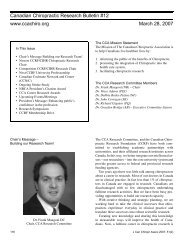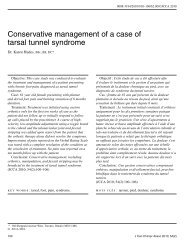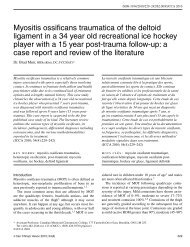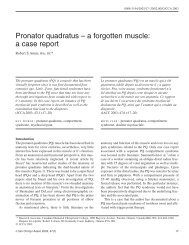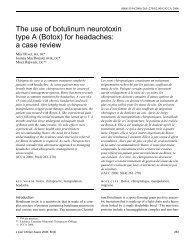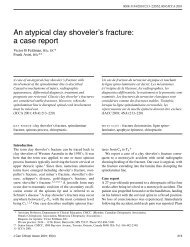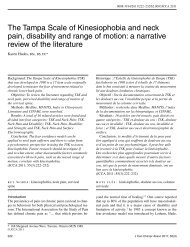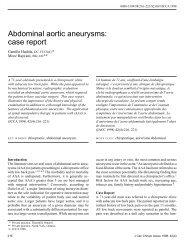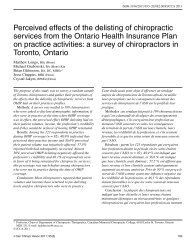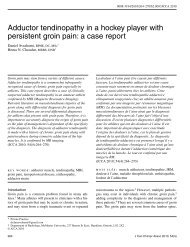download PDF - Journal of the Canadian Chiropractic Association
download PDF - Journal of the Canadian Chiropractic Association
download PDF - Journal of the Canadian Chiropractic Association
Create successful ePaper yourself
Turn your PDF publications into a flip-book with our unique Google optimized e-Paper software.
0008-3194/2005/301–311/$2.00/©JCCA 2005Oswald Hall, PhD: <strong>Chiropractic</strong> advocate;1971 to 1998Douglas M Brown, DC*Oswald Hall is one <strong>of</strong> <strong>the</strong> “outsiders” who haspr<strong>of</strong>oundly impacted <strong>Canadian</strong> chiropractic and byextension, its various constituencies. The purpose <strong>of</strong> thispaper is to document how Dr. Hall used <strong>the</strong> depth andbreadth <strong>of</strong> knowledge and experience assimilated in hiscareer, to interact with <strong>the</strong> chiropractic pr<strong>of</strong>ession and<strong>the</strong> <strong>Canadian</strong> Memorial <strong>Chiropractic</strong> College (CMCC).Dr. Hall’s main achievement for chiropractic was toquietly, firmly, yet politely, open doors for <strong>the</strong> acceptanceby and <strong>of</strong> chiropractic and CMCC into <strong>the</strong> arena <strong>of</strong>graduate level pr<strong>of</strong>essional education. He did this inthree ways: Dr. Hall’s first step took place in 1973,when as Chair <strong>of</strong> <strong>the</strong> Task Force on <strong>Chiropractic</strong> for<strong>the</strong> OCH, he assisted <strong>the</strong> committee to make positiverecommendations regarding our education andpractice. Dr. Hall’s second step was his contributionto <strong>the</strong> sociological study culminating in <strong>the</strong> book,“Chiropractors: Do They Help.” His third, and mostcomplex initiative began in 1982 when he joined <strong>the</strong>CMCC Board. His stamina and affability were testedduring his sixteen year tenure on <strong>the</strong> UniversityAffiliation Committee as <strong>the</strong> College endured protracted,failed attempts to unite with <strong>the</strong> University <strong>of</strong> Victoria,BC (1988–1992) and York University, Toronto, ON(1995–2001).(JCCA 2005; 49(4):301–311)key words: chiropractic, history, university affiliation.Oswald Hall est un de ses ‘indépendants’ qui apr<strong>of</strong>ondément marqué la chiropractie canadienne et parprolongation, ses différentes clientèles. L’objectif decet article est de documenter la façon, dont le Dr. Halla mis en pratique la pr<strong>of</strong>ondeur et l’étendue de sesconnaissances assimilées, au cours de sa carrière pourinteragir avec la pr<strong>of</strong>ession de la chiropractie et le<strong>Canadian</strong> Memorial <strong>Chiropractic</strong> College (CMCC).L’accomplissement principal du Dr. Hall pour lachiropractie a été d’ouvrir les portes, de façon calme,ferme, mais polie pour que la chiropractie et le CMCC,soient acceptés et accèdent au niveau d’éducationd’un deuxième cycle universitaire. Il a réalisé cetaccomplissement de trois façons: En 1973, le Dr. Hall,en tant que président de la commission d’étude de lachiropractie pour l’OCH, a franchi le premier paslorsqu’il a secondé le comité pour soumettre desrecommandations positives, reliées à notre formation età l’exercice de notre pr<strong>of</strong>ession. Le Dr Hall a franchila deuxième étape lorsqu’il a collaboré à l’étudesociologique culminée dans le livre ‘Chiropractors: Do<strong>the</strong>y help.’ La troisième initiative du Dr. Hall et la pluscomplexe, a débuté en 1982 lorsqu’il s’est joint au comitédu CMCC. Son endurance et sa courtoisie ont été mises àl’épreuve, au cours de son mandat d’une durée de 16années sur le comité d’affiliation de l’université, lorsquele collège échouait dans des tentatives, prolongéesindéfiniment pour s’affilier avec les universitéssuivantes : University <strong>of</strong> Victoria, BC (1988–1992) etYork University, Toronto, Ontario (1995–2001).(JACC 2005; 49(4):301–311)mots clés : chiropractie, historique, affiliationuniversitaire.* 281 Ridgewood Road, Toronto, Ontario M1C 2X3, Phone: 416-284-1168; E-mail: DBrown4741@aol.com© JCCA 2005.J Can Chiropr Assoc 2005; 49(4) 301
Oswald HallIntroductionOswald Hall has long been recognized by his peers forhis pervasive and enduring influence on <strong>the</strong> emergenceand direction <strong>of</strong> sociology in Canada. 1 However, his persistentadvocacy <strong>of</strong> chiropractic is not well known.Since our inception in 1895, chiropractic has enduredrelentless opposition, shrill criticism, pr<strong>of</strong>essional isolationand perhaps worst <strong>of</strong> all, indifference. It is understandablethat we sometimes feel as though <strong>the</strong> wholeworld is against us. Actually this is not <strong>the</strong> case; at leastnot in Ontario, where we have had outside support almostsince chiropractors first arrived here in 1902. For example,in 1925 chiropractors were first legislated in Ontariounder <strong>the</strong> Drugless Practitioners Act and in 1937 legitimizedby inclusion under <strong>the</strong> Worker’s CompensationAct. In both instances much <strong>of</strong> chiropractic’s successfullobbying has been attributed to public support we receivedfrom organized labour. In 1945, a variety <strong>of</strong> labourgroups began petitioning government bodies to add chiropracticcoverage to national and provincial health insuranceplans. O<strong>the</strong>r proponents were members <strong>of</strong> <strong>the</strong>legislature. These external pressures culminated in 1970when <strong>the</strong> Honourable Thomas L. Wells, Minister <strong>of</strong>Health, described as being “much more sympa<strong>the</strong>tic tochiropractors,” announced <strong>the</strong> inclusion <strong>of</strong> chiropracticservices under what is now <strong>the</strong> Ontario Hospital InsurancePlan (OHIP). 2Oswald Hall is one <strong>of</strong> <strong>the</strong> “outsiders” who has pr<strong>of</strong>oundlyimpacted <strong>Canadian</strong> chiropractic and by extension,its various constituencies. The purpose <strong>of</strong> this paperis to document how Dr. Hall used <strong>the</strong> depth and breadth<strong>of</strong> knowledge and experience assimilated in his career, tointeract with <strong>the</strong> chiropractic pr<strong>of</strong>ession and <strong>the</strong> <strong>Canadian</strong>Memorial <strong>Chiropractic</strong> College (CMCC).Oswald Hall, PhDOntario Council <strong>of</strong> HealthOswald Hall “first learned <strong>of</strong> chiropractic during <strong>the</strong> SecondWorld War. In <strong>the</strong> Harvard library I encounteredsome medical journals and discovered <strong>the</strong> prolonged feudbetween chiropractic and medicine in North America.When I came to <strong>the</strong> University <strong>of</strong> Toronto in 1956 I wasgiven an <strong>of</strong>fice at 273 Bloor Street, and discovered thatCMCC was across <strong>the</strong> street. I had planned to study itsdevelopment, but it moved (thanks to <strong>the</strong> subway) to itspresent location. About that time I met Don Su<strong>the</strong>rland,<strong>the</strong> president, and soon <strong>the</strong>reafter Jean Moss. We becamefriends.” [Letter Hall to Brown, Oct. 5, 2001]In 1965 <strong>the</strong> Ontario Council <strong>of</strong> Health (OCH), <strong>the</strong> majoradvisory body to <strong>the</strong> Ontario Department <strong>of</strong> Healthwas created and Dr. Hall was named one <strong>of</strong> its originalmembers. He remained <strong>the</strong>re until 1971, helping to reorganizehealth services, developing community healthcentres and building <strong>the</strong> frameworks <strong>of</strong> health disciplineboards. In 1971, shortly after leaving <strong>the</strong> OCH, Hall wasnamed chair <strong>of</strong> <strong>the</strong> Committee on Human Resources’newly created Task Force on Education and Practice <strong>of</strong>Chiropractors in Ontario. This committee served under<strong>the</strong> auspices <strong>of</strong> <strong>the</strong> OCH. Its terms <strong>of</strong> reference were: “Toidentify <strong>the</strong> area <strong>of</strong> practice for chiropractors and to study<strong>the</strong> implications with respect to regulation and educationin chiropractic. With respect to regulation, attentionshould be given to <strong>the</strong> area <strong>of</strong> practice in which chiropractorsmay receive and treat patients directly.” 3 Its objectiveswere tw<strong>of</strong>old: to make recommendationsregarding: “Scope <strong>of</strong> Practice;” and “Educational Requirements.”In addition to Dr. Hall <strong>the</strong> o<strong>the</strong>r task force302 J Can Chiropr Assoc 2005; 49(4)
Oswald Hall<strong>of</strong> <strong>the</strong> <strong>Canadian</strong> Medical <strong>Association</strong> <strong>of</strong> June 1972 ...Finally, it noted <strong>the</strong> apparently increasing demand inOntario for chiropractic services.” 5During its deliberations <strong>the</strong> task force reached consensusin a number <strong>of</strong> areas: “In developing an educationalprogram, one should keep in mind that <strong>the</strong> body <strong>of</strong>knowledge a pr<strong>of</strong>essional needs must be beyond <strong>the</strong> practicalrequirements for <strong>the</strong> job ... <strong>Chiropractic</strong> educationshould complement, but not attempt to parallel medicaleducation ... CMCC should be maintained as a separateand identifiable institution ... Chiropractors would welcomea requirement for a pre-pr<strong>of</strong>essional period in universityto help achieve a more uniform preparation <strong>of</strong>students entering <strong>the</strong> CMCC ... Chiropractors see activetreatment hospital experience as important but feel <strong>the</strong>irstudents would benefit even more from ambulatory clinicexperience ... As a first step toward defining educationalobjectives, a statement <strong>of</strong> clinical competencies whichchiropractors must possess to function within <strong>the</strong>ir definedscope <strong>of</strong> practice was developed.” [Summary <strong>of</strong>Task Force Activities, April–June, 1972] Following thisfirst step <strong>the</strong> task force wrote general objectives <strong>of</strong> chiropracticeducation and specific guidelines for teaching <strong>the</strong>basic sciences, and clinical chiropractic. 6By December 1972 <strong>the</strong> task force had completed PhaseII <strong>of</strong> its investigation. In its final report to <strong>the</strong> OCH, underEducational Objectives, <strong>the</strong> committee listed eight recommendations.Although recommendation 1, states thatCMCC should be maintained as a distinctive identifiableinstitution, because <strong>of</strong> <strong>the</strong> benefits that accrue to itthrough recognition, support and morale, recommendation2 concedes that ultimately, CMCC should be broughtwithin <strong>the</strong> public educational system and to accomplishthis, “It is desirable that <strong>the</strong> College be joined to a university.”Secondary suggestions involved replacing CMCC’sbasic sciences courses with those <strong>of</strong> a university, maintainingCMCC’s existing facilities for clinical training,and augmenting that instruction with programs in hospitalsand community health centres. 7Dr. Robert Wingfield has made some interesting observations<strong>of</strong> Dr. Hall as chairman <strong>of</strong> <strong>the</strong>se deliberations.“Dr. Oswald Hall was impressive, impartial, very fair andbroad minded. Our pr<strong>of</strong>ession never had that kind <strong>of</strong> experiencebefore. Enquiries prior to that had always beenadversarial. Dr. Hall changed that attitude right away. Forexample, Dr. Hall was very collegial, preferring to sit at<strong>the</strong> centre <strong>of</strong> <strong>the</strong> table ra<strong>the</strong>r than <strong>the</strong> end where chairmenusually sat. Dr. George Connell was as collegial and impartialas Dr. Hall.“I think Dr. Hall was selected as chairman because <strong>of</strong>his forward thinking views. He saw a need for cooperationbetween <strong>the</strong> pr<strong>of</strong>essions and believed chiropractorsknew when to intervene and when not to intervene. Hewanted to make recommendations that would encouragegrowth. In fact, at our first meeting Dr. Hall stated that‘We would have to stop thinking in terms <strong>of</strong> independentdisciplines and ra<strong>the</strong>r accept <strong>the</strong> concept <strong>of</strong> interdependentpr<strong>of</strong>essions that would all fit into a legislative framework.’“The task force was seen by some chiropractors as ahuge threat to <strong>the</strong> pr<strong>of</strong>ession. As <strong>the</strong> work progressed<strong>the</strong>re was definitely a feeling that <strong>the</strong> OCH wanted to createa role for chiropractors as manipulative technicianseducated in a community college. Later, when <strong>the</strong> issuesinvolving <strong>the</strong> scope <strong>of</strong> practice had been resolved, <strong>the</strong>ministry proposed sets <strong>of</strong> instructional guidelines thatwould form <strong>the</strong> basis <strong>of</strong> defining what chiropractors do,in order to create educational requirements that wouldsatisfy <strong>the</strong> needs <strong>of</strong> <strong>the</strong> act. At times like <strong>the</strong>se Dr. Hallwould say, ‘This is very interesting. Of course if this isdone and that is done, it is going to restrict <strong>the</strong> growth <strong>of</strong><strong>the</strong> pr<strong>of</strong>ession.’ On numerous occasions Dr. Hall supported<strong>the</strong> concept <strong>of</strong> developing <strong>the</strong> pr<strong>of</strong>ession ra<strong>the</strong>r thanrestricting it.“In <strong>the</strong> second stage <strong>of</strong> meetings we began to developeducational requirements. The first idea presented wasthat we should be in a community college. Drs. Connell,Su<strong>the</strong>rland and I visited Humber College where it becameimmediately clear that <strong>the</strong>y could not provide <strong>the</strong>type <strong>of</strong> education we envisioned for ourselves. Dr. Connellagreed and <strong>of</strong>fered to write <strong>the</strong> report for <strong>the</strong> taskforce. Following Dr. Connell’s report, <strong>the</strong> idea <strong>of</strong> a communitycollege did not come up again ...“In <strong>the</strong> end, <strong>the</strong> task force helped us to define ourselvesas a pr<strong>of</strong>ession.” [Interview Wingfield by Brown, June18, 2003]Dr. Hall deserves <strong>the</strong> last word regarding <strong>the</strong> taskforce. “The newly formed Ontario Council <strong>of</strong> Healthasked me to chair a committee <strong>of</strong> two chiropractors andtwo doctors to explore <strong>the</strong> question as to whe<strong>the</strong>r <strong>the</strong>study <strong>of</strong> <strong>Chiropractic</strong> belonged in a university setting.Both <strong>the</strong> committee and <strong>the</strong> Council announced a clear304 J Can Chiropr Assoc 2005; 49(4)
DM Brown‘Yes.’ However departments <strong>of</strong> Health and <strong>of</strong> Educationwere cool to <strong>the</strong> idea, and it remained in limbo.” [LetterHall to Brown, Oct. 5, 2001]“Chiropractors, Do They Help?”In 1976 Dr. Hall, along with Merrijoy Kelner, PhD, andIan D. Coulter, PhD, became a co-investigator in <strong>the</strong> largestempirical investigation <strong>of</strong> <strong>Canadian</strong> chiropractors everundertaken. The results <strong>of</strong> this 1976–79 study, conductedunder <strong>the</strong> auspices <strong>of</strong> <strong>the</strong> Department <strong>of</strong> Behavioural Science,University <strong>of</strong> Toronto, and funded by a $460,000grant from <strong>the</strong> National Health Research and DevelopmentProgram, Health and Welfare Canada, were publishedin <strong>the</strong> 1980 book, “Chiropractors: Do They Help?” 8In <strong>the</strong> preface, Stephen Griew, PhD, Chair, Department<strong>of</strong> Behavioural Science, University <strong>of</strong> Toronto, explainsthat while universities do not structure <strong>the</strong>ir research programswith a view to achieving immediate results, immediatepractical consequences frequently occur. “Such is<strong>the</strong> case with Chiropractors: Do They Help? Althoughfirmly rooted in <strong>the</strong> strictest standards <strong>of</strong> social scienceresearch, it is a highly readable book which can onlyserve to inform <strong>the</strong> debate about chiropractic, a branch <strong>of</strong>health care long surrounded by prejudices and misconceptions... Chiropractors: Do They Help? Contains noclinical evaluation <strong>of</strong> chiropractic. None <strong>of</strong> <strong>the</strong> researcherswas equipped to make such evaluations, and this wasnot a goal <strong>of</strong> <strong>the</strong> research in <strong>the</strong> first place. The goalswere, first, to learn from face-to-face interviews with chiropractorswhat <strong>the</strong>y do in <strong>the</strong>ir work, what <strong>the</strong>y knowabout healing, and how <strong>the</strong>y learned <strong>the</strong>ir knowledge andskills. The second goal was to interview representativepatients about <strong>the</strong>ir experience with chiropractic care.The third goal was to spend whole days in <strong>the</strong> <strong>of</strong>fices <strong>of</strong>chiropractors to observe what <strong>the</strong>y do to and for <strong>the</strong>ir patients,and to combine this information with what hadbeen learned from chiropractors and patients.”Dr. Hall described <strong>the</strong> book’s objective succinctly: “Itis simply to discover who does what to whom, for whatreasons, and in what ways is <strong>the</strong> chiropractor educatedand trained to do this.” Dr. Coulter writes: “The study,<strong>the</strong>refore, involved an in-depth analysis <strong>of</strong> a single chiropracticcollege (Canada’s only such college) from <strong>the</strong>point <strong>of</strong> view <strong>of</strong> an organization, pr<strong>of</strong>essional socializationand, more importantly, an analysis <strong>of</strong> <strong>the</strong> content<strong>of</strong> education from <strong>the</strong> perspective <strong>of</strong> <strong>the</strong> sociology <strong>of</strong>knowledge. This analysis was <strong>the</strong>n linked to a study <strong>of</strong>practitioners, <strong>the</strong>ir clinics and <strong>the</strong>ir patients. The latter involvedboth interviewing and observation <strong>of</strong> all aspects <strong>of</strong><strong>the</strong> clinic including patient care. A total <strong>of</strong> 349 practitionerswas interviewed, seventy clinics were observed, and658 patients were interviewed. All <strong>the</strong> samples were randomlycollected.“The results <strong>of</strong> this study were in stark contrast tomany <strong>of</strong> <strong>the</strong> earlier ones. It was clear that chiropractichad established itself very firmly within <strong>the</strong> health caresystem, that it had established various and extensive interpr<strong>of</strong>essional contacts, albeit some <strong>of</strong> which were donesurreptitiously, that it attracted students <strong>of</strong> high educationalattainment and that its patient population, with <strong>the</strong>exception <strong>of</strong> age, was a very close representation <strong>of</strong> <strong>the</strong><strong>Canadian</strong> population at large.” 9The book closes with a set <strong>of</strong> recommendations designedto remove barriers in areas that prevent chiropracticfrom fully contributing to <strong>the</strong> health care system andpublic welfare. Those areas include: open referral; wideracceptance; institutional support; and inclusion in governmen<strong>the</strong>alth insurance schemes. Its postscript providesa brief summary: “This study began as an obstinate effortto take a genuinely fresh look at <strong>the</strong> place <strong>of</strong> chiropracticin an expanding health care system ... What became clearduring <strong>the</strong> research, and was far from apparent when itbegan, is that chiropractic has evolved a distinctive model<strong>of</strong> health care, has developed a distinctive model <strong>of</strong>health education, has found a broad measure <strong>of</strong> social acceptanceand appears to have a distinctive contribution tomake to an overall system <strong>of</strong> health care.” 10Dr. Merrijoy Kelner enjoyed her collaboration with Dr.Hall during <strong>the</strong> chiropractic investigation. “To those <strong>of</strong> uswho have had <strong>the</strong> privilege <strong>of</strong> working with Oswald Hallin <strong>the</strong> years since his <strong>of</strong>ficial retirement, he has providedan inspiring role model <strong>of</strong> <strong>the</strong> ‘older’ pr<strong>of</strong>essional ... Oswaldhas continued to work as enthusiastically and productivelyas ever as a colleague on our study <strong>of</strong> <strong>the</strong>chiropractic pr<strong>of</strong>ession. His output was prodigious, setting<strong>the</strong> pace for <strong>the</strong> rest <strong>of</strong> us, and his experience andwisdom added significance and depth to all our efforts.“While many people appear to grow more rigid withage, Oswald seems never to lose his openness to new insightsand fresh perspectives. He retains his lifelong capacityto rethink issues and to change direction in <strong>the</strong>face <strong>of</strong> convincing new evidence.J Can Chiropr Assoc 2005; 49(4) 305
Oswald Hall“Far from standing on ceremony as <strong>the</strong> senior scholaron <strong>the</strong> project, Oswald insisted on being treated as ‘one<strong>of</strong> <strong>the</strong> gang.’ The younger, more junior people on <strong>the</strong>project were amazed to find that he related to <strong>the</strong>m all aspr<strong>of</strong>essional equals, never seeking privileges or pullingrank.” 11Dr. Coulter found <strong>the</strong> process stimulating and educational.Coulter first met Hall when he was hired to join <strong>the</strong>investigative team about a year after its inception. Hallsoon assumed a dominant role. “In many ways Oswald’swork on chiropractic was a very natural extension <strong>of</strong> hiswork on health pr<strong>of</strong>essions ... Much <strong>of</strong> Oswald’s work,and hence his contribution to sociology , consisted in expanding<strong>the</strong> application <strong>of</strong> sociological thinking and conceptsto new areas ... Oswald combined two very crucialcharacteristics in his work. First a very deeply held curiosityabout what people did, what <strong>the</strong>y thought, how socialstructures were formed, or how <strong>the</strong>y really worked ... Theo<strong>the</strong>r great characteristic Oswald had was his ability to usesociological concepts to illuminate <strong>the</strong> findings ...“Oswald also possessed one o<strong>the</strong>r characteristic whichI have never encountered in any o<strong>the</strong>r academic. Most <strong>of</strong>us in academia develop frameworks in terms <strong>of</strong> which weconduct our analyses and particularly our writings ...Sometimes we stick with <strong>the</strong>se for a lifetime, sometimes<strong>the</strong>y last no longer than <strong>the</strong> particular project we areworking on. Oswald could literally change his from oneday to <strong>the</strong> next. We would be shaping one <strong>of</strong> <strong>the</strong> chaptersfor <strong>the</strong> book dealing with education and/or <strong>the</strong> collegeand he would suggest that we might construe this chapteras <strong>the</strong> making <strong>of</strong> a chiropractor looked at from <strong>the</strong> point<strong>of</strong> view <strong>of</strong> what we had learnt about <strong>the</strong> practice. I would<strong>the</strong>n go away and write up <strong>the</strong> material along <strong>the</strong>se lines.The very next day Oswald would say something like,‘seen in <strong>the</strong> cold light <strong>of</strong> day that framework looks lesscompelling; why don’t we look at it as a socializationinto <strong>the</strong> principles and philosophy <strong>of</strong> chiropractic.’ Whilethis used to drive me to distraction, and in some caseslead not to just 10 distinct revisions <strong>of</strong> a single chapterbut 10 distinct versions <strong>of</strong> a chapter, I used to be amazedhe could do this ...“This was actually superb training in how to write,how to polish a manuscript. Oswald wrote very well himself.His articles read well and <strong>the</strong>y <strong>of</strong>ten seem like basiccommon sense. There is no sense <strong>of</strong> <strong>the</strong> work he put in toget <strong>the</strong>m to read this way ...“One <strong>of</strong> <strong>the</strong> really intriguing things for me about Oswaldis that having put a tremendous amount <strong>of</strong> effortinto <strong>the</strong> book he never published ano<strong>the</strong>r thing <strong>of</strong>f <strong>the</strong>project. We had masses <strong>of</strong> data which did not make it into<strong>the</strong> book but he did not show <strong>the</strong> slightest interest in any<strong>of</strong> it. Once he had told <strong>the</strong> story <strong>the</strong> way he thought itshould be told in <strong>the</strong> book that was it for him ...“I recall how gentle and patient Oswald was with mewhen I was learning to write. In some ways I had an apprenticeshipunder Oswald that lasted about 5 years. AlthoughI am sure if you asked him, and probably me, wewould not say he mentored me. When I look back, that isexactly what he was doing. But in typical Oswald fashion,he would never say, “you should do this,” but simply,“I wonder if you have thought <strong>of</strong> doing it this way.” In<strong>the</strong> long run, this is probably a very effective method forinfluencing someone.” [E-mail Coulter to Brown, June 4,2003]Oswald Hall and CMCCThe earliest mention <strong>of</strong> Dr. Hall in <strong>the</strong> CMCC archives isOctober 3, 1976, when <strong>the</strong> Minutes <strong>of</strong> a CMCC Board <strong>of</strong>Governors meeting record Dr. Su<strong>the</strong>rland, <strong>the</strong>n President/Administrative Dean, recommending a modest honorariumto Dr. Hall for his assistance with College matters. Atthat time Hall was spending a lot <strong>of</strong> time at CMCC ga<strong>the</strong>ringinformation for “Chiropractors: Do They Help?”On October 29, 1977, at <strong>the</strong> CMCC Board Annual GeneralMembership Meeting, Hall reviewed <strong>the</strong> progress <strong>of</strong>this University <strong>of</strong> Toronto study, and on August 20, 1978,David Churchill, DC, Chairman <strong>of</strong> <strong>the</strong> CMCC Senate, remarkedthat Dr. Hall understood <strong>the</strong> unique relationshipbetween <strong>the</strong> <strong>Canadian</strong> chiropractic pr<strong>of</strong>ession and <strong>the</strong>College, with <strong>the</strong> Board acting as its surrogate owner.In October 1982, Dr. Hall was nominated to serve as apublic member on <strong>the</strong> CMCC Board and appointed to itsreorganized University Affiliation Committee. 12 At its inauguralmeeting, December 8, 1982, three distinguishededucators from outside <strong>the</strong> pr<strong>of</strong>ession were listed amongits ten members: Oswald Hall, PhD, Pr<strong>of</strong>essor Emeritus,Department <strong>of</strong> Sociology, University <strong>of</strong> Toronto; DonaldG. Ivey, PhD, Vice-President University Relations, University<strong>of</strong> Toronto; and David Steinhauer, retired Director<strong>of</strong> Educational and Cultural Exchange, Ontario Department<strong>of</strong> Education. “These men gave <strong>the</strong> University AffiliationCommittee guidance, impetus and credibility.” 13 .306 J Can Chiropr Assoc 2005; 49(4)
DM BrownAlthough this committee was euphemistically termed “adhoc,” Hall remained <strong>the</strong>re until his retirement from <strong>the</strong>College Board in 1998. In 1983 he also became a longstandingmember <strong>of</strong> <strong>the</strong> Academic Affairs Committee.Coulter had already discovered Hall’s writing skillsand <strong>the</strong>y were quickly utilized. The first part <strong>of</strong> <strong>the</strong>CMCC 1983–84 strategic university affiliation plan, approvedin December 1982, called for <strong>the</strong> creation <strong>of</strong> aclear, concise description <strong>of</strong> <strong>the</strong> College’s current statusand its vision for <strong>the</strong> future. This document was aimed atdistribution to universities and government agencies. InJuly 1983, with considerable input from Hall, <strong>the</strong> “<strong>Canadian</strong>Memorial <strong>Chiropractic</strong> College Prospectus” was finalized.In <strong>the</strong> foreword, three phases <strong>of</strong> CMCC’s historicdevelopment are briefly outlined before stating: “TheCollege envisages its next phase as one <strong>of</strong> definite incorporationinto <strong>the</strong> large health care system. In part this hasbeen already accomplished through <strong>the</strong> appointment <strong>of</strong>o<strong>the</strong>r health care practitioners to <strong>the</strong> faculty <strong>of</strong> <strong>the</strong> Collegeand through informal liaison with o<strong>the</strong>r teaching institutions.As <strong>the</strong> next step <strong>the</strong> College seeks formalaffiliation with an established university ...”The summary <strong>of</strong> <strong>the</strong> Prospectus explains that, “Inmany ways CMCC provides a model for what can beachieved in private pr<strong>of</strong>essional education ... However, asboth law and optometry found before <strong>the</strong>m, it has isolatedchiropractic from <strong>the</strong> mainstream <strong>of</strong> pr<strong>of</strong>essional educationwhich in Canada, is now largely synonymous withuniversity education ... It is <strong>the</strong>refore an appropriate timefor chiropractic to take its place amongst <strong>the</strong> full range <strong>of</strong><strong>the</strong> disciplines that comprise <strong>the</strong> health science faculties<strong>of</strong> <strong>the</strong> universities in Canada.”Examples <strong>of</strong> Dr. Hall’s editorial contributions to <strong>the</strong>Academic Affairs Committee can be found in CMCC’s1990 “<strong>Chiropractic</strong> Paradigm <strong>of</strong> Health and HealthCare,” and its 1991 “CMCC Mission Statement.” Theparadigm statement is brief: “<strong>Chiropractic</strong> articulates aphilosophy <strong>of</strong> health. The chiropractic model <strong>of</strong> healthand health care includes <strong>the</strong> art and science <strong>of</strong> prevention,diagnosis and treatment <strong>of</strong> abnormalities <strong>of</strong> structure andfunction <strong>of</strong> <strong>the</strong> neuromusculoskeletal system for <strong>the</strong> purpose<strong>of</strong> enhancing <strong>the</strong> health <strong>of</strong> <strong>the</strong> whole person, primarily,but not only, through <strong>the</strong> use <strong>of</strong> <strong>the</strong> chiropracticadjustment.” CMCC’s mission “is to benefit societythrough <strong>the</strong> pursuit <strong>of</strong> knowledge and <strong>the</strong> education <strong>of</strong>chiropractors so that <strong>the</strong>y may acquire <strong>the</strong> understandingand skills necessary to apply this knowledge and contributeeffectively to <strong>the</strong> health care team.”Back in 1981, <strong>the</strong> Commission on Accreditation <strong>of</strong> <strong>the</strong>Council on <strong>Chiropractic</strong> Education (Canada) was harshlycritical <strong>of</strong> <strong>the</strong> CMCC Board <strong>of</strong> Governors. 14 But by 1986,when <strong>the</strong> College achieved Accredited Status it had beentransformed from a board “deeply involved in administrativematters,” into one, “mainly concerned with policyformation, accountability and fund raising.” 15 The vehiclefor this transformation was education. It began in1981 when <strong>the</strong> Board became a member <strong>of</strong> <strong>the</strong> <strong>Association</strong><strong>of</strong> Governing Boards <strong>of</strong> Universities and Colleges inWashington, DC, and expanded in 1982 when <strong>the</strong> Boardbegan hosting instructional seminars following its annualand semi-annual meetings, holding annual retreats during<strong>the</strong> summer months and developing an orientation manualand informative sessions for new members.Dr. Hall was a strong proponent <strong>of</strong> this process. He attendedalmost all <strong>the</strong>se events, where his unassumingmanner and keen intellect made lasting impressions on<strong>the</strong> o<strong>the</strong>r participants. For instance, on October 22, 1994,<strong>the</strong> CMCC Board held an educational seminar on <strong>the</strong>“Roles and Responsibilities <strong>of</strong> <strong>the</strong> Board <strong>of</strong> Governors.”The main focus <strong>of</strong> Board discussion on this day was amemo, “Responsibility <strong>of</strong> Board Members,” prepared by<strong>the</strong> Board’s Legal Counsel, Allan M. Freedman, LLB.This article “deals with <strong>the</strong> obligations <strong>of</strong> <strong>the</strong> members <strong>of</strong><strong>the</strong> Board <strong>of</strong> Governors to report to is membership and toparticipate in <strong>the</strong> ongoing affairs <strong>of</strong> <strong>the</strong> pr<strong>of</strong>ession whilemaintaining <strong>the</strong>ir obligations as a member <strong>of</strong> <strong>the</strong> Board<strong>of</strong> Governors.” It goes on to describe <strong>the</strong> history <strong>of</strong>CMCC’s move to a “presidential model <strong>of</strong> governance”and explains that this “form <strong>of</strong> governance implies andsets out, as a fact, that <strong>the</strong> operation <strong>of</strong> <strong>the</strong> College is centredaround <strong>the</strong> President.” These remarks were intendedto “provide some understanding to ‘new’ members <strong>of</strong> <strong>the</strong>Board as to <strong>the</strong> model <strong>of</strong> organization which was establishedby <strong>the</strong> Board <strong>of</strong> Governors <strong>of</strong> CMCC, namely ‘<strong>the</strong>Presidential Model.’ In understanding that <strong>the</strong> Board <strong>of</strong>Governors chose to adhere to such a model, <strong>the</strong> interaction<strong>of</strong> <strong>the</strong> President and her/his Board might be betterunderstood and appreciated.”Excerpts from a letter to <strong>the</strong> CMCC Board Chair fromDr. Hall, commenting on Mr. Freedman’s memo, show<strong>the</strong> depth <strong>of</strong> Hall’s understanding <strong>of</strong> both its need andJ Can Chiropr Assoc 2005; 49(4) 307
Oswald Hallusefulness: “May I comment on <strong>the</strong> September 19 letterby our eminent solicitor. The item is long, but well organizedand cogently presented. It seems to be most appropriateas a guide to new members coming on <strong>the</strong> Board ...This document provides some very sharp guidance to <strong>the</strong>newcomer. It is also useful to current members who, in<strong>the</strong> hurly burly <strong>of</strong> pressing problems, may lose sight <strong>of</strong><strong>the</strong> essential guidance <strong>of</strong> his letter. It lets us sharpen ourunderstanding <strong>of</strong> <strong>the</strong> really complex obligations <strong>of</strong> a trustee... It is very helpful to have a document that not onlygives us an anchor in a time <strong>of</strong> turmoil, but also signals<strong>the</strong> road we must follow if we are trustworthy trustees.(We must continually earn that trust!)”Dr. Ian Coulter became President <strong>of</strong> CMCC in 1983, ayear after Dr. Hall arrived on <strong>the</strong> scene, and <strong>the</strong>y wereclose collaborators until Coulter left <strong>the</strong> College in 1990.Coulter remembers that when Hall joined <strong>the</strong> Board, “Hebrought his great knowledge <strong>of</strong> education generally, hisknowledge <strong>of</strong> what pr<strong>of</strong>essions were about (or should beabout), a tremendous tolerance and willingness to helpthose on <strong>the</strong> Board who were struggling to understand<strong>the</strong>ir responsibilities and obligations, and just down rightcommon good sense.” Coulter also saw Hall as a moderator.“While many <strong>of</strong> <strong>the</strong> conflicts we got into upset him,he always did his best to see <strong>the</strong> o<strong>the</strong>r side and try towork out a compromise. I think he felt very stronglyabout <strong>the</strong> goodness <strong>of</strong> chiropractic and it was really upsettingto him to see some members acting unpr<strong>of</strong>essionallyand hell bent on hurting <strong>the</strong> pr<strong>of</strong>ession.” [E-mailCoulter to Brown, June 4, 2003]Many <strong>of</strong> us who had <strong>the</strong> good fortune to work with Dr.Hall thought <strong>of</strong> him as a fa<strong>the</strong>r-figure and mentor. PeterG. Magee, DC, was on <strong>the</strong> Board from 1982 to 1996. Herecalls: “At Board meetings, Oswald did not speak very<strong>of</strong>ten but he listened to everything. When he did participatehe brought a larger frame <strong>of</strong> reference to our discussionswithout making anyone feel small. He had notrouble speaking to people <strong>of</strong> all generations ... His keenmind, energy and sense <strong>of</strong> self are something to be admired.”[E-mail Magee to Brown, June 6, 2005]Vincent K. Sinclair, DC, Board Chair, 1994 to 1996,sought Hall’s advice: “As Board Chair, I soon learned tocount on Oswald’s wisdom and <strong>of</strong>ten consulted with himon matters that were beyond my scope. Interestingly, hewould never give you a direct response but he had <strong>the</strong>ability to make you seek <strong>the</strong> answer within his usual articulateand metaphorically oratorical style.” [E-mail Sinclairto Brown, May 12, 2005]Jean A. Moss, DC, President, CMCC, has fond memories:“Oswald Hall is one <strong>of</strong> those people who has greatimpact on one’s life, if only for <strong>the</strong> clarity <strong>of</strong> thought hebrought to everything he did. I recall having him read apaper I was writing and he gave very valuable input intoproducing a much better paper. But he was not just interestedin academic matters; he had a wide range <strong>of</strong> interestsand views on <strong>the</strong> events in <strong>the</strong> world around him ...Oswald had <strong>the</strong> knack <strong>of</strong> taking a wide range <strong>of</strong> ideas anddistilling <strong>the</strong>m into succinct points ... he added tremendouslyto <strong>the</strong> Board discussions. It was during this timethat CMCC was dealing with some difficult issues includingUniversity Affiliation. His advice and insightwere invaluable.” [E-mail Moss to Brown, June 1, 2005]The author has benefited from knowing Dr. Hall since1982. In <strong>the</strong> 1990s Hall and Coulter helped me produce atriad <strong>of</strong> historical papers on CMCC’s attempts at universityaffiliation. Hall’s most effusive comment on mywriting was, “You appear to be making some progressDouglas. Carry on! Margaret McCallen, who has been<strong>the</strong> Board’s Recording Secretary since 1991 writes: “Interactionwith Oswald is always pleasant because he has acheerful disposition, always a kind thing to say and an interestingstory to tell.” [E-mail, McCallen to Brown, May12, 2005] Hall also has an original sense <strong>of</strong> humour. Atone event, it was <strong>the</strong> author’s pleasure to present him to<strong>the</strong> audience. Dr. Hall stepped to <strong>the</strong> podium and announced,“Over <strong>the</strong> years I have received numerous introductions,but tonight, Dr. Brown’s was <strong>the</strong> most recent.”On ano<strong>the</strong>r occasion Hall informed me that, “Retirementis alright, as long as it doesn’t interfere with your work.”Major AccomplishmentDr. Hall’s main achievement for chiropractic was to quietly,firmly, yet politely, open doors for <strong>the</strong> acceptance byand <strong>of</strong> chiropractic and CMCC into <strong>the</strong> arena <strong>of</strong> graduatelevel pr<strong>of</strong>essional education.He did this in three ways: Dr. Hall’s first step tookplace in 1973, when as Chair <strong>of</strong> <strong>the</strong> Task Force on <strong>Chiropractic</strong>for <strong>the</strong> OCH, he assisted <strong>the</strong> committee to makepositive recommendations regarding our education andpractice. In outlining a fairly broad scope for chiropractors,<strong>the</strong> committee endorsed chiropractic as a viable, primarycontact health pr<strong>of</strong>ession. Among its educational308 J Can Chiropr Assoc 2005; 49(4)
DM Brownobjectives were recommendations that CMCC be maintainedas a distinctive, identifiable institution, that it befunded as part <strong>of</strong> <strong>the</strong> public educational system and, ifpossible, eventually joined to a university. These boldproposals flew in <strong>the</strong> face <strong>of</strong> a 1970 report by <strong>the</strong> OntarioCommittee on <strong>the</strong> Healing Arts which advised placingchiropractic education within a college <strong>of</strong> applied artsand technology, as well as requiring patients to obtain adifferential diagnosis from a physician, prior to commencingchiropractic care. Had <strong>the</strong>se restrictive policiesbeen implemented <strong>the</strong>y would have reduced us to <strong>the</strong> level<strong>of</strong> technicians, under direct supervision by <strong>the</strong> medicalpr<strong>of</strong>ession. 16Dr. Hall’s second step was his contribution to <strong>the</strong> sociologicalstudy culminating in <strong>the</strong> book, “Chiropractors:Do They Help.” The inquiry, like Dr. Hall, was uniquelydifferent. It varied from previous sociological investigationsin that chiropractic was approached with a minimum<strong>of</strong> sociological “rhetoric.” Its purpose was to ga<strong>the</strong>ras much factual information as possible and to let <strong>the</strong> sociologicalinterpretation and conceptualization be basedon this data. The results were also at variance from formerprobes in that chiropractic was seen as complementaryand mainstream ra<strong>the</strong>r than marginal. This study and<strong>the</strong> book that followed, helped to alter <strong>the</strong> way social scientistsview chiropractic. Coulter believes <strong>the</strong> implications<strong>of</strong> <strong>the</strong>se changes are important. “Sociological writingsare influential. They are frequently referred to and,in some instances, relied upon by legislative bodies. Tothis extent <strong>the</strong>y have a political life <strong>of</strong>ten distinct from,and independent <strong>of</strong>, <strong>the</strong>ir authors. Fur<strong>the</strong>rmore, in academicinstitutions <strong>the</strong>y are <strong>the</strong> source works used to introduceo<strong>the</strong>r health pr<strong>of</strong>essionals, particularly healthplanners, to chiropractic.” 17Dr. Hall’s third, and most complex initiative began in1982 when he joined <strong>the</strong> CMCC Board. His stamina andaffability were tested during his sixteen year tenure on<strong>the</strong> University Affiliation Committee as <strong>the</strong> College enduredprotracted, failed attempts to unite with <strong>the</strong> University<strong>of</strong> Victoria, BC (1988–1992) 18 and York University,Toronto, ON (1995–2001). Fortunately Hall has a raregift which gave him an advantage. That gift was perception.Coulter noted Hall’s farsightedness when <strong>the</strong>y werega<strong>the</strong>ring research for <strong>the</strong> book, “Chiropractors: Do TheyHelp?” “Oswald had this incredible store house <strong>of</strong> knowledgeby <strong>the</strong> time I met him (he would have been in his70s I think). This knowledge also made Oswald verywise. I recall when we were at <strong>the</strong> College, <strong>the</strong> studentsorganized a protest strike which resulted in <strong>the</strong> Dean beingfired and a fairly major disruption at <strong>the</strong> College. Amember <strong>of</strong> <strong>the</strong> research team wrote us this piece about<strong>the</strong> six major crises at <strong>the</strong> College which virtually concludedthat <strong>the</strong> College might not survive. At our meetingto discuss this, Oswald sat back and said, ‘Look, this Collegewas founded at a very difficult time during <strong>the</strong> war;it has suffered incredible hardships along <strong>the</strong> way; muchconflict, in fighting and court actions; this is simply atempest in a tea cup. Institutions are much hardier thanyou are giving <strong>the</strong>m credit for. Next year <strong>the</strong>y will noteven remember what this was about.’ The amazing thingis that by <strong>the</strong> time we finished <strong>the</strong> project, many <strong>of</strong> thosewho were at <strong>the</strong> College at <strong>the</strong> time did not remember <strong>the</strong>six crises, and as history has shown, <strong>the</strong> College has survivedvery nicely.” [E-mail, Coulter to Brown, June 4,2003]In 1983 Dr. Hall wrote an unpublished article, “TheFuture History <strong>of</strong> <strong>the</strong> <strong>Canadian</strong> Memorial <strong>Chiropractic</strong>College,” in which he poses <strong>the</strong> question, “How will universityaffiliation affect CMCC?” Hall had no difficultyimagining what would happen to students and faculty, butwas less certain how <strong>the</strong> Board <strong>of</strong> Governors and CMCCmembers would fare. Hall believed <strong>the</strong> Board would nolonger be responsible for educational policy, and thatpublic funding would lift much <strong>of</strong> <strong>the</strong> financial burdenfrom <strong>the</strong> members’ shoulders. He saw this as an opportunityfor CMCC “to pursue more effectively <strong>the</strong> objectiveswhich <strong>the</strong> founding fa<strong>the</strong>rs glimpsed so perceptively.”Dr. Hall lists three ambitious objectives <strong>of</strong> CMCC’sfounders: “To promote <strong>the</strong> development <strong>of</strong> <strong>the</strong> science<strong>of</strong> chiropractic ... To improve <strong>the</strong> pr<strong>of</strong>essional standing<strong>of</strong> <strong>the</strong> members ... To establish schools for <strong>the</strong> study <strong>of</strong>chiropractic.” [Minutes <strong>of</strong> <strong>the</strong> Organization Meeting <strong>of</strong><strong>the</strong> Dominion Council <strong>of</strong> <strong>Canadian</strong> Chiropractors (now<strong>Canadian</strong> <strong>Chiropractic</strong> <strong>Association</strong>) January 10, 1943]Hall felt that university affiliation would emancipateCMCC financially, allowing its members to “actually pinpoint<strong>the</strong>ir resources at <strong>the</strong> cutting edge <strong>of</strong> <strong>the</strong> advance <strong>of</strong>chiropractic science.” Sometimes foresight can be cloudedby unpredictable events and <strong>of</strong> course, hindsight is alwaysperfect. Hall could not know that over <strong>the</strong> next twodecades, federal and provincial governments would drasticallycurtail <strong>the</strong> funding <strong>of</strong> higher education in Canada.J Can Chiropr Assoc 2005; 49(4) 309
Oswald HallActually, while Hall was convinced that chiropractic trainingbelonged in <strong>the</strong> arena <strong>of</strong> graduate pr<strong>of</strong>essional education,he was ambivalent about how this should beaccomplished. And he was not alone. Wingfield records:“Arguments against going into a university were strong, asdemonstrated by <strong>the</strong> minutes <strong>of</strong> our April 11, 1972 meeting.‘Mr. Su<strong>the</strong>rland said <strong>the</strong> pr<strong>of</strong>ession probably wouldprefer to retain its College as an identifiable institution andpreferably have <strong>the</strong> basis sciences program taught in <strong>the</strong>irown institution ... It was noted that <strong>the</strong>re may be certainadvantages to having <strong>the</strong> independent College (e.g., bequests,endowments). Also, Dr. Hall said, <strong>the</strong> <strong>Chiropractic</strong>College had been able to maximize, through its isolation,a higher degree <strong>of</strong> enthusiasm among students than is usuallygenerated in university pr<strong>of</strong>essional schools.’” [InterviewWingfield by Brown, June 18, 2003]Still, it looked as though joining a university couldease <strong>the</strong> debt load <strong>of</strong> chiropractic students until deregulation<strong>of</strong> fees for pr<strong>of</strong>essional programs dashed thosehopes. By 1999–2000 tuition at CMCC was over $12,000while medical students at <strong>the</strong> University <strong>of</strong> Western Ontariowere paying $10,000. 19 Ironically, in 2003–2004 <strong>the</strong>tide reversed. Tuition for first year students at CMCC was$17,317 while <strong>the</strong> cost for first year University <strong>of</strong> Torontodental students rose to $17,950. [University <strong>of</strong> TorontoUndergraduate Admission Guidelines (DDS), 2003–2004] Suddenly CMCC’s fees became competitive withthose <strong>of</strong> o<strong>the</strong>r health pr<strong>of</strong>essions.On March 1, 2001, after six years <strong>of</strong> apparently harmoniousefforts to formalize an agreement <strong>of</strong> affiliation,York University abruptly cancelled all negotiations withCMCC. Dr. Moss recalls: “Dr. Hall was deeply disappointedwith <strong>the</strong> decision by York University and by <strong>the</strong>way in which we were treated by York. I remember himsaying to me after <strong>the</strong> decision was finalized that for <strong>the</strong>first time he felt that CMCC would be better <strong>of</strong>f if it remainedindependent and that it did not deserve to betreated in this manner.” Thankfully, on April 4, 2005,<strong>the</strong>re was a dramatic improvement in our fortunes: TheOntario Ministry <strong>of</strong> Training, Colleges and Universitieshonoured CMCC by awarding it degree granting status.When <strong>the</strong> author informed Dr. Hall <strong>of</strong> this momentousdecision, he was jubilant. “At last, CMCC has been formallyinducted into <strong>the</strong> realm <strong>of</strong> higher education. We nolonger need university affiliation!” [Phone call Brown toHall, April 14, 2005]When last we talked (June 16, 2005), Dr. Hall’s insightwas as penetrating as it had been in 1983, when he typed<strong>the</strong> last paragraph <strong>of</strong> his “Future History <strong>of</strong> CMCC.”“The astute founders <strong>of</strong> CMCC foresaw clearly two abidingproblems <strong>of</strong> <strong>the</strong> chiropractic pr<strong>of</strong>ession. They alerted<strong>the</strong>ir following to <strong>the</strong> dangers <strong>of</strong> traditional dogmas andsimplistic catch words by pushing vigorously <strong>the</strong> development<strong>of</strong> <strong>the</strong>ir science. Moreover, <strong>the</strong>y emphasized <strong>the</strong>need for an unending struggle to improve <strong>the</strong> pr<strong>of</strong>essionalstanding <strong>of</strong> <strong>the</strong> members <strong>of</strong> <strong>the</strong> pr<strong>of</strong>ession, realizing thatcompeting pr<strong>of</strong>essions would not be resting on <strong>the</strong>ir oars.In this context <strong>the</strong>y bequea<strong>the</strong>d to <strong>the</strong>ir followers a sturdyteaching institution, which in <strong>the</strong>ir eyes was an essentialfirst tool for tackling <strong>the</strong>se problems. The challengewhich <strong>the</strong>y left this generation <strong>of</strong> chiropractors is to buildon <strong>the</strong> legacy which <strong>the</strong>y left, and on <strong>the</strong> vision which inspiredthose ancestors. If <strong>the</strong>y could speak again <strong>the</strong>ywould say “The past is not Epilogue, it is Prologue.”AcknowledgementThe author is grateful to Dr. Oswald Hall and Dr. IanCoulter for <strong>the</strong>ir assistance in ga<strong>the</strong>ring and organizinginformation for this paper.References1 Wipper A. The sociology <strong>of</strong> work in Canada: papers inhonour <strong>of</strong> Oswald Hall. 2nd. ed. Ottawa: CarltonUniversity Press, 1994.2 Biggs CL. No bones about chiropractic? The quest forlegitimacy by <strong>the</strong> Ontario chiropractic pr<strong>of</strong>ession 1895–1985. Toronto, 1989. University <strong>of</strong> Toronto Libraries,<strong>the</strong>ses COMMH 1990 PhD 1989:160–61, 331–32, 334,338.3 A report <strong>of</strong> <strong>the</strong> Ontario Council <strong>of</strong> Health: Scope <strong>of</strong>practice and educational requirements for chiropractors inOntario. Toronto: Ontario Council <strong>of</strong> Health, 1973.4 Ibid. 5–6.5 Ibid. 17.6 Ibid. Appendix C.7 Ibid. 18–23.8 Kelner M, Hall O, Coulter I. Chiropractors: do <strong>the</strong>y help?Toronto: Fitzhenry & Whitesides, 1980.9 Coulter ID. <strong>Chiropractic</strong> observed: thirty years <strong>of</strong> changingsociological perspectives: <strong>Chiropractic</strong> History 1983;3(1):47.10 Kelner M, Hall O, Coulter I. Chiropractors: do <strong>the</strong>y help?Toronto: Fitzhenry & Whitesides, 1980; 257.11 Wipper A. The sociology <strong>of</strong> work in Canada: papers inhonour <strong>of</strong> Oswald Hall. 2nd. ed. Ottawa: CarltonUniversity Press, 1994; 166.310 J Can Chiropr Assoc 2005; 49(4)
DM Brown12 Brown DM. CMCC’s persistent pursuit <strong>of</strong> universityaffiliation Part II: Knocking on doors and heads in Ontario1969 to 1988. JCCA 1994; 31(1):51–52.13 Brown DM. Ian Douglass Coulter, PhD: CMCC’sadventurous president. JCCA 2004; 48(1):39.14 Resolution by <strong>the</strong> Commission on Accreditation <strong>of</strong> <strong>the</strong>Council on <strong>Chiropractic</strong> Education (Canada), March 26,1982, p. 1.15 Brown DM. The path to full accreditation: CMCC and itsGovernors, 1945–86. JCCA 1987; 7(1):17.16 Report <strong>of</strong> <strong>the</strong> Committee on <strong>the</strong> Healing Arts, IR Dowie.Queen’s Printer, Ontario Ministry <strong>of</strong> Government Services,1970:46.17 Coulter ID. <strong>Chiropractic</strong> observed: thirty years <strong>of</strong> changingsociological perspectives: <strong>Chiropractic</strong> History 1983;3(1):47.18 Brown DM. CMCC’s persistent pursuit <strong>of</strong> universityaffiliation, Part III: <strong>the</strong> push for union with <strong>the</strong> University<strong>of</strong> Victoria, BC, 1988 to 1992. JCCA 1996; 40(2):87–99.19 Brown DM. <strong>Chiropractic</strong> in Canada: illicit to elite in <strong>the</strong>first century (Millennium Commentary). JCCA 1999;43(04):216–218.Support <strong>Chiropractic</strong> ResearchYour gift will transform chiropracticBecome a member <strong>of</strong> <strong>the</strong><strong>Canadian</strong> <strong>Chiropractic</strong> Research Foundation and help us establishuniversity based <strong>Chiropractic</strong> Research Chairs in every provinceContact Dr. Allan GotlibTel: 416-781-5656 Fax: 416-781-0923 Email: algotlib@ccachiro.orgJ Can Chiropr Assoc 2005; 49(4) 311



